How to train a climbing rose – expert tips for growing beautiful blooms up a range of structures
Discover the best ways to train climbing roses up supports and tie in delicate stems

Roses are ever-popular favorites that are loved worldwide for their fantastic blooms and scent. As well as shrub, modern, or hybrid tea roses, gardeners can also use climbing roses to bring extra height and drama to a backyard.
Climbing roses can be trained to grow up a variety of supports, including walls, fences, arches, trellises, and more. They can be used as features in rose garden ideas and also cover unsightly areas that are usually bare of planting.
Whatever you want to train them up, the general method of how to train a climbing rose remains the same. You always want to select the best stems and tie them to the chosen support to fill the space and put on a dramatic show of blooms.
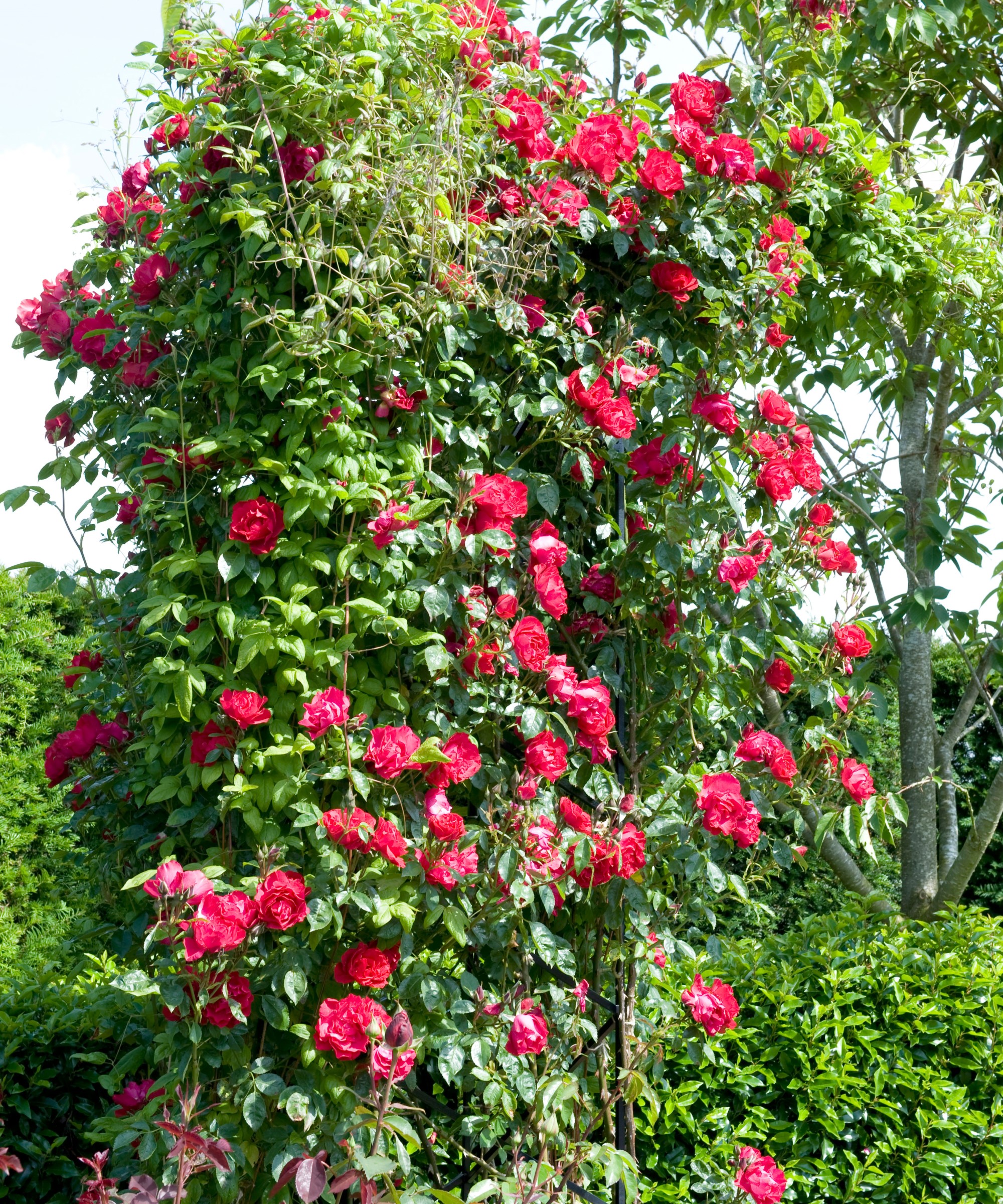
Climbing roses will cover their supports
How to train climbing roses
All of the best climbing roses need some form of support structure. This structure both provides stability and helps to guide the growth of the rose, so can form an important part of designing a rose garden.
Philip Crowther, Business Development Manager at Prestige Flowers, recommends that the climbing rose is positioned ‘about six to eight inches’ from the base of the climbing plant support structure ‘to allow for proper airflow’. The main stems are then gently encouraged to climb up the support and secured into place.
When it comes to tying the climbing roses into place, he adds: ‘I would recommend using soft, flexible ties or twine made from natural materials like jute or soft plant ties. These materials are gentle on the stems and allow for flexibility as the rose grows. Avoid using wires or materials that can constrict or damage the stems.
‘To tie them, loosely secure the rose stems to the support structure using figure-eight or twist ties. This method provides stability while allowing room for growth and prevents the ties from digging into the stems.’
Design expertise in your inbox – from inspiring decorating ideas and beautiful celebrity homes to practical gardening advice and shopping round-ups.
Plant ties such as the YDSL Soft Plant Tie, available at Amazon, have a soft rubber surface and will not damage plants when used to tie roses. Such soft ties are durable and flexible and I used them regularly during my time as a professional gardener.
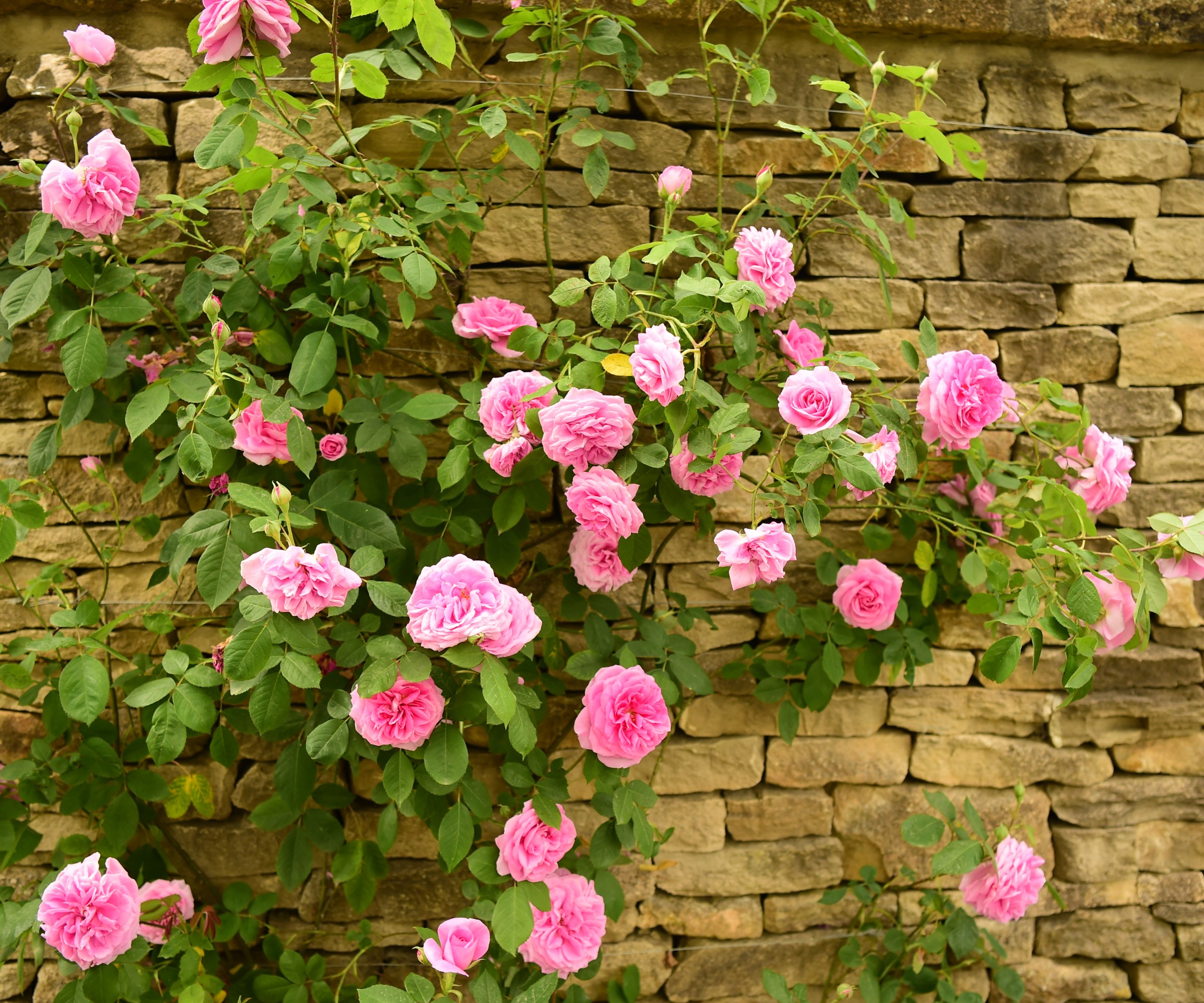
Walls can be wired up to train climbing roses up
How to train a climbing rose on a wall
Training a climbing rose against a wall is a fantastic way of utilizing an otherwise bare space and turning it into a stunning feature. The roses can bring color and fragrance to the wall, or alternatively it can be trained against a fence in the same way.
Graham Rice, gardening expert for Homes & Gardens, advises that a factor ‘often overlooked’ is the color of the wall or garden fence that the rose is to be trained to climb, and making sure to pick a rose that works well against it.
‘Roses with white or cream flowers won’t stand out well against pale brick or stone,’ he warns. ‘And remember that timber fences tend to become paler in color after weathering for a year or two, so think ahead.’
Walls and fences either need straining wires set up or a trellis put in place in order to train the rose to. Always put these in place before you begin training your rose.
The experts at David Austin Roses recommend: ‘Place the lowest straining wire 2 feet from the ground, repeating every 12-18 inches up the wall or fence, up to the mature height of the rose.
‘The span on the straining wires should cover the width you want the rose to fill. Use vine eyes every 5ft along the length to hold the wire in place and stop it from sagging.’
You can get straining wire and turnbuckle kits for roses online that are ideal for fitting to walls. A good example is this Garden Trellis Wire Kit available at Amazon.
The healthiest canes of your climbing rose should be selected and fanned out evenly into the space, before being secured onto the structure. Space these canes well apart and then the secondary shoots, which are the ones which will be full of blooms, will fill out the gaps between.
Pruning climbing roses will be important every late winter or early spring, as well as deadheading roses throughout the blooming period. Extend stems outwards where possible and, from the second year onwards, you can curve or arch them to fill the space and this will encourage more production of flowers.
Always ensure to use clean and sharp pruning shears whenever pruning or deadheading. This portable Corona AC 8300 Tool Blade Sharpener available at Amazon can fit in a pocket or bag to sharpen shears on the go.

Graham has a wealth of knowledge in all things horticulture. He trained at the prestigious Royal Botanic Gardens in Kew, England, and since then has written more than 20 books on plants and gardening. He gardened in Pennsylvania for 20 years, but has recently returned to his native England.
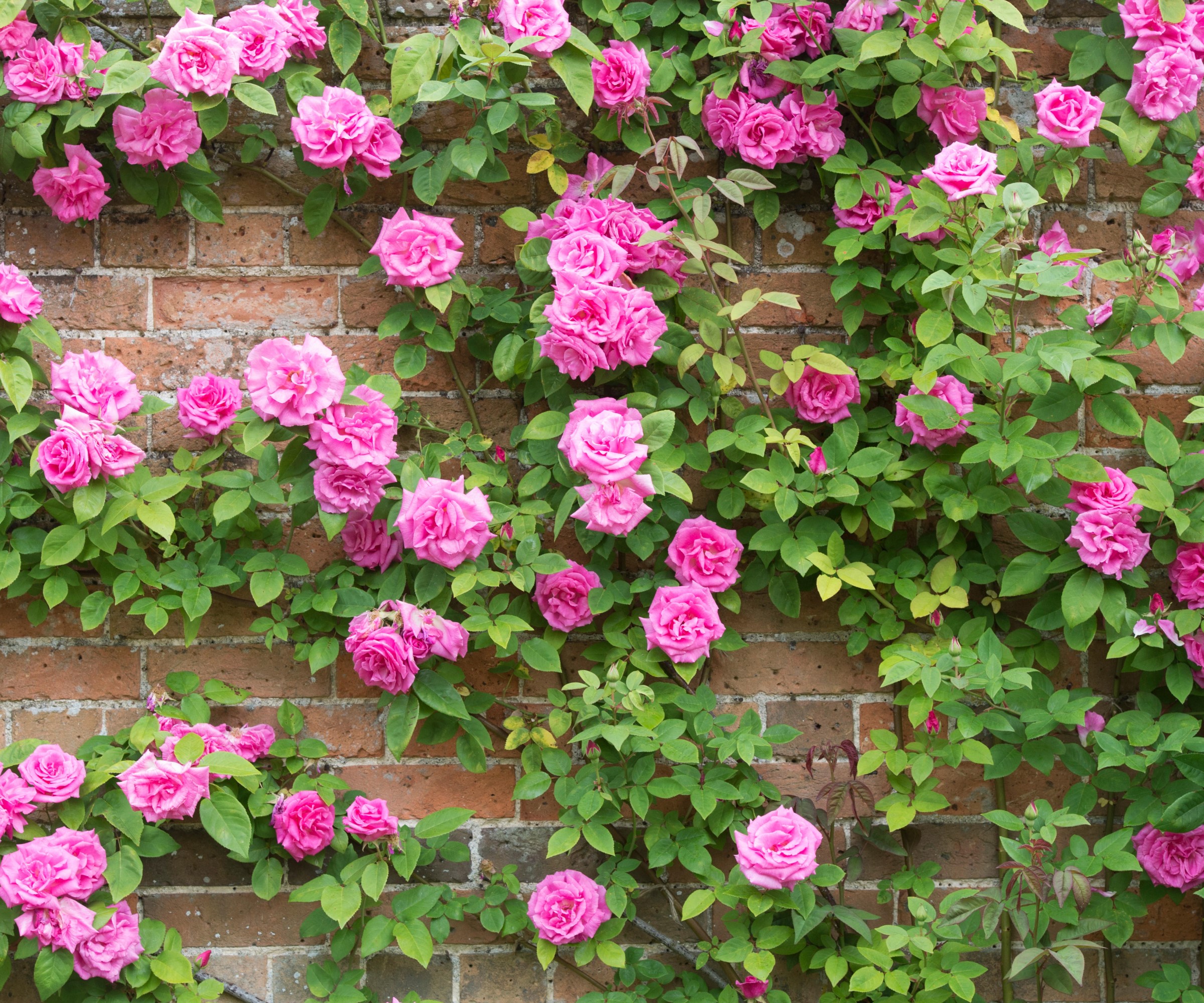
Climbing roses can cover otherwise blank and unsightly spaces
How to train a climbing rose on a trellis
The method to train a climbing rose on a trellis is the same as outlined above for walls. Any trellis should be placed around 3-5 inches from the wall, as that allows shoots to climb behind it and for air to circulate behind the plant. Secure the stems of the climbing rose to the trellis using soft material, tying every 12-15 inches, including bending flexible new canes to cover more of the space.

A trellis needs to be firmly secured to a wall
How to train climbing roses on an arch
An arch is a great focal point that raises blooms beautifully into the air. Arches can be made of metal or wood and need to be thoroughly secured into the ground.
Plant one climbing rose on either side of the arch and train the stems as they grow up the frame. The aim is to give even coverage of the archway, with the two roses meeting in the center at the top. Therefore the roses need to be tied in as they grow upwards and over the top of the frame.
This garden arch on Amazon is highly sturdy and features a striking geometric design that is perfect for climbing roses to ascend. The heavy-duty black wrought-iron frame is capable of supporting roses for many years.
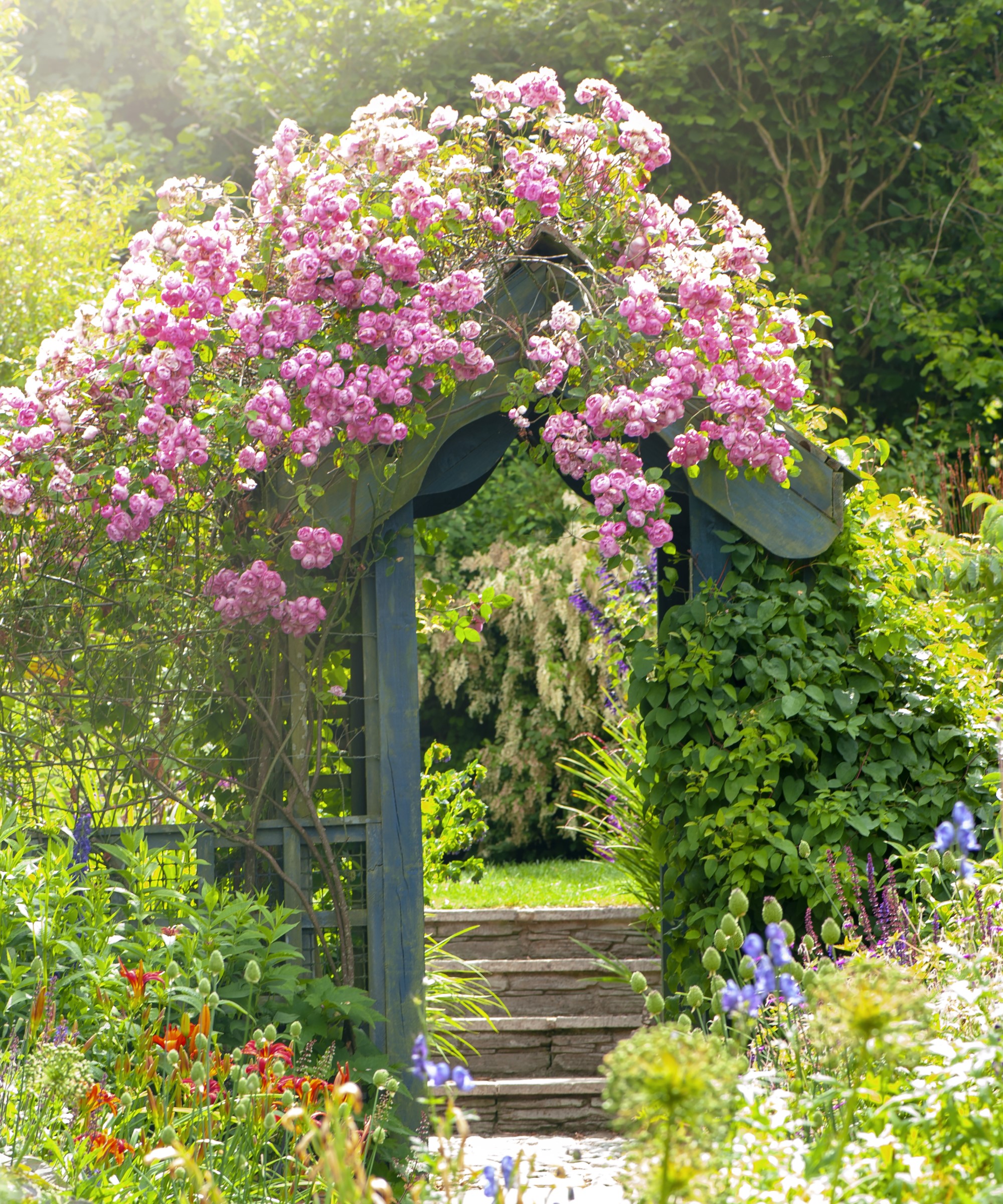
Arches look stunning covered in the blooms of climbing roses
How to train a climbing rose up a post
A climbing rose can be trained to grow up a post or pillar to create a fantastic-looking vertical structure. These pillars can make a real statement when in full bloom, giving vertical color to a flower bed. The pillar must to be well anchored and wires need to be run up the pillar. Train the stems of the rose in a spiral around the post, tying them to the pillar around every eight inches.
How to train a climbing rose on an obelisk
An obelisk offers another great opportunity to grow tall plants when you do not have walls to utilize. They can come in many styles or materials, from woven willow to sleek metal, and can be used as a centrepiece in backyard ideas. This metal garden obelisk from Amazon would work well in both modern and more traditional gardens.
When it comes to training climbing roses on an obelisk, the experts at David Austin Roses advise to ‘train a couple of the main stems straight up to the top of the structure’.
‘Then spiral the other stems around the structure, tying-in as you go – this encourages flowers from the ground upwards. Once the stems have reached the top, regularly prune to keep them within bounds.’
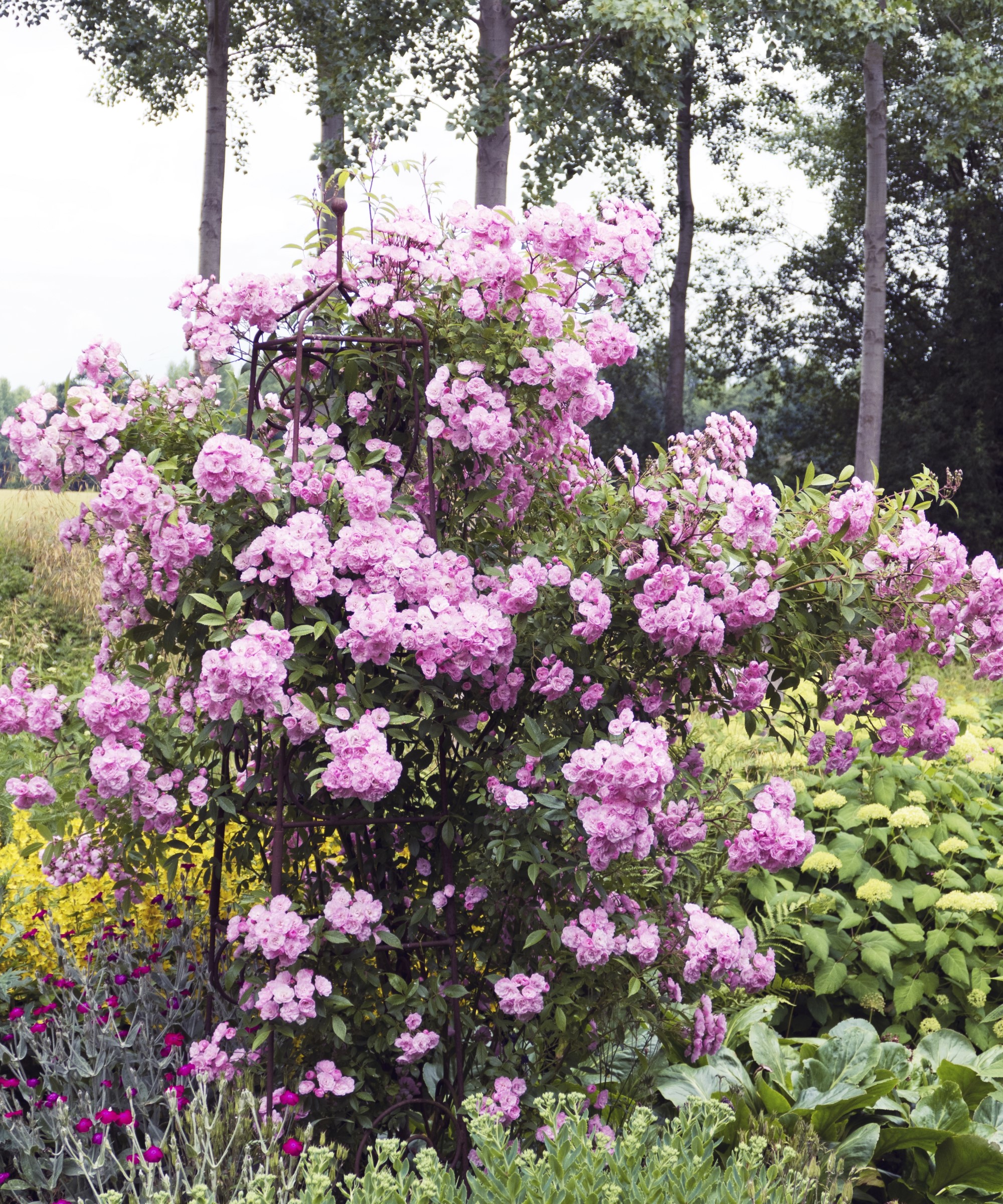
An obelisk can provide drama in among beds
How to train a climbing rose on a pergola
The frame of a pergola can be completely covered in a climbing rose to create a stunning walkway or shady spot for protection from the sun. To train a rose up a pergola, you first use the same method for the pillar of the pergola as training a climbing rose up a post. This creates an artistic spiral of flowers that skirts up the pillar before the shoots are then tied to the cross-beans of the pergola roof.
Alternatively, if you just want flowers to cover the roof of the structure, you can train the shoots straight up the posts.
FAQs
How do you shape a climbing rose?
Regular pruning is essential to managing and shaping the growth of climbing roses. Neglecting pruning is a common rose pruning mistake and will make shaping a climbing rose much more difficult.
Philip Crowther advises that you remove dead, damaged or weak stems to ‘encourage healthy growth’ as well as ‘prune long, unruly stems to redirect growth and maintain the desired shape'.
‘As the rose grows, ensure that the stems are securely tied to the structure. Redirect any wayward stems towards the desired direction and gently tie them in place.’
Climbing roses are very versatile and really offer a lot of potential as fast-growing plants that can make a real difference to a space.
Not only do climbing roses look magnificent but many can also lay claim to being some of the best fragrant roses you can get. It may take a bit of time to get them to cover a structure and it may require a bit of attention to tie in and train the stems, but it is all worth it though when you see the stunning blooms shooting airborne and filling the space with outstanding fragrance.

Drew has worked as a writer since 2008 and was also a professional gardener for many years. As a trained horticulturist, he worked in prestigious historic gardens, including Hanbury Hall and the world-famous Hidcote Manor Garden. He also spent time as a specialist kitchen gardener at Soho Farmhouse and Netherby Hall, where he grew vegetables, fruit, herbs, and cut flowers for restaurants. Drew has written for numerous print and online publications and is an allotment holder and garden blogger. He is shortlisted for the Digital Gardening Writer of the Year at the 2025 Garden Media Guild Awards.